The creative boom in empty buildings
- Published
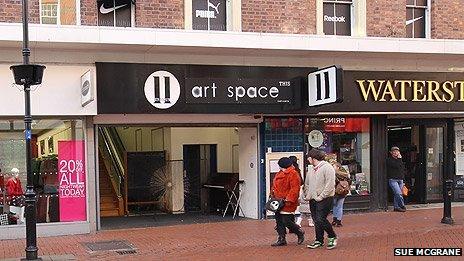
The Un Deg Un art space is making use of the old JJB Sports shop in Wrexham
For most people, empty shops and offices are an eyesore and unwelcome evidence of an economic downturn. But for artists, desperate for a cheap place to work and exhibit, they are a godsend.
Across the UK, more and more grassroots artists, designers and performers are taking advantage of empty buildings by moving in, with low or no rent, while landlords wait for new commercial tenants or wait for developments to begin.
The likes of Damien Hirst and Sarah Lucas started their careers by staging shows in such spaces in the late 1980s. Now Dan Thompson, who runs the Empty Shops Network, external, says the activity has "really taken off" in the past couple of years.
"It's gone from being a fringe, slightly edgy activity to something very mainstream," he says. "It feels like a golden age for the arts with so much going on."
The supermarket office
.markhoughton.image-stephenilesv.4.jpg)
Artist Mark Houghton made sculptures from old office chairs and shelves
An eight-floor office block in central Manchester, which was part of the Co-op Supermarket until the company moved to a new head office, has been taken over by the Castlefield Gallery, external.
Each floor of the Federation building is being used by a different arts group, with hip-hop theatre creator Benji Reid, external in the basement and cinema collective Filmonik, external upstairs.
Visual arts agency Mark Devereux Projects, external was the first to hold an exhibition there earlier this month, filling what still looks very much like a scruffy open-plan office.
"This is what artists and creative people do - we try and make the most of opportunities that come our way," Devereux says. The artists in his opening exhibition included Mark Houghton, external, who created sculptures from items he found including office chairs and shelves.
The Castlefield has the building rent-free on a five-year lease, which the Co-op can break if they find a new tenant in the meantime. The building will eventually be part of a major redevelopment - but that is still a long way off.
The police station
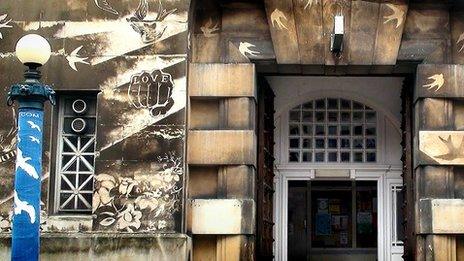
The police station was earmarked for redevelopment, which fell through in 2008
It was once Bristol city centre's main police station, a fire station and magistrates' court.
But in 2008, artists, musicians, dancers and circus performers took over the Bridewell complex. There are now sound studios in the cells and artists' studios in the old confiscated goods lock-up.
The building was bought by property developer Urban Splash after the police officers and court clerks moved out in 2005. There was a plan to turn it into flats and a hotel - but that got put on hold when the economic crisis struck.
A group called Artspace Lifespace, external moved in for an initial 12 months. Five years later, the development is still on hold and the artists are still in the complex, known as The Island, external.
The furniture warehouse
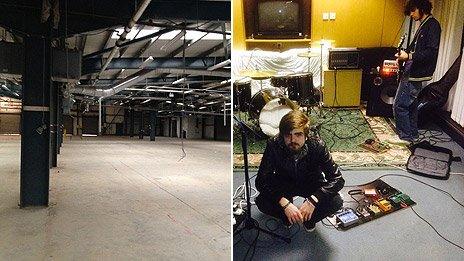
Bands including Allusondrugs are using the complex for rehearsals
Carleton Furniture was once one of the UK's leading corporate furniture manufacturers.
It went into administration in 2011 and now its vast warehouse and office complex in Pontefract, West Yorkshire, is being taken over by musicians and artists.
So far, the bands Allusondrugs, external and Above Ground, external and singer Rose Wheeler, external have moved in and are using it for rehearsals.
"I can be as loud as I want and I've got so much space and freedom and I'm not at home annoying anyone," Wheeler says. "So for me it's about being able to be creative in emptiness."
The complex could also be used for visual art, sound art and theatre prop storage. It is managed by Leeds-based East Street Arts, external, a charity that pairs artists with empty properties.
From taking on one empty building three years ago, East Street now looks after 100 spaces.
"There's always stuff standing empty for a while, but in the current economic climate it's much more accentuated," says East Street's Ken Stratford. "And on the High Street, the changing nature of retailing is another factor."
Using vacant properties makes sense for artists because they often need a lot of space but have little money, he says. For landlords, it is a way to avoid having to pay business rates, utility bills and insurance while their premises are empty.
The sports shop
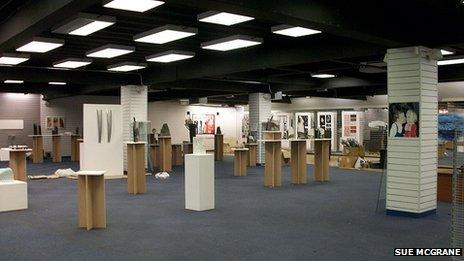
The shop hosted the North Wales School of Art and Design's degree show
When JJB Sports went into administration last October, its branch in Wrexham was left vacant. Until, that is, it was taken over by artists who now use it for exhibitions, gigs, workshops and a spoken word night.
Named Un Deg Un, external, the pop-up venue had 3,500 visitors for the local art college's graduate exhibition this summer.
For the current show, artists were given £20 each to spend in the town's market and tasked with using their purchases to create installations.
"There aren't that many opportunities to show art in a place where the public is," says Dave Gray. "You're often relying on bringing them to a gallery, whereas this is right on the High Street.
"Also people tend to hang around the space so it's really good for creating collaborations between artists that otherwise would not have happened.
"An empty shop is of no use to anyone and has an impact on the High Street. Having a creative and visually attractive things in those spaces has a benefit to the entire environment of Wrexham. It acts as a bit of an attraction in itself."
The car showroom
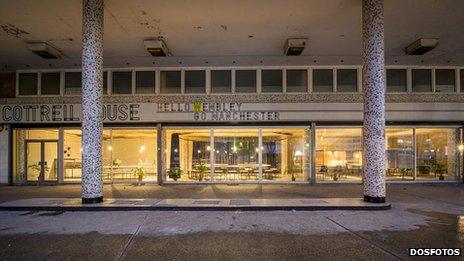
Designers and entrepreneurs have been in the old showroom for four months
The forecourt of a 1960s car showroom in the shadow of Wembley Stadium recently doubled as a catwalk when fashion designer Ulrika Becker, external unveiled her 2014 collection there.
Becker is based in the showroom, Cottrell House, external, which is also home to other designers, artists and entrepreneurs, and hosts regular art exhibitions.
These creative types have been in the building for four months so far. Project manager Jessica Courtney Bennett, of Meanwhile Spaces, external, says there was no previous artistic community in Wembley, meaning people had to leave the area to find studios or galleries.
"It's created a bit of a hub for some of those types of people to start to come to, although it's all very informal at the moment," she says. "It's definitely starting to show that you can do things in this area."
The BT office
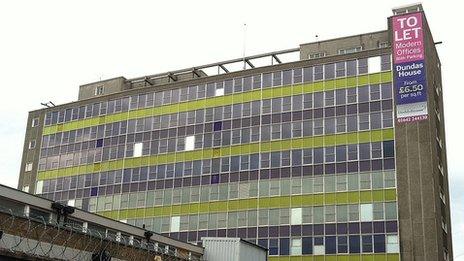
Artists will use Dundas House until a commercial tenant is found
Dundas House, an eight-storey 1960s carbuncle in the heart of Middlesbrough, was most recently occupied by BT.
The company moved out in 2011 and 20 artists have moved in, filling it with studios, exhibitions, workshops and other random happenings.
A recent project involved events and exhibitions inspired by the site's former life as the town's Winter Gardens.
One of the other happenings, an experimental "making" weekend, inspired artist Cath Keay, external to create beehives modelled on some of the town's other concrete monstrosities. The idea is to draw parallels between bee colonies and our own urban life, and to encourage an interest in beekeeping.
The artists, led by Navigator North, external, have use of the building for the foreseeable future, until a commercial tenant is found.
The brewery, the chippy, the barracks...
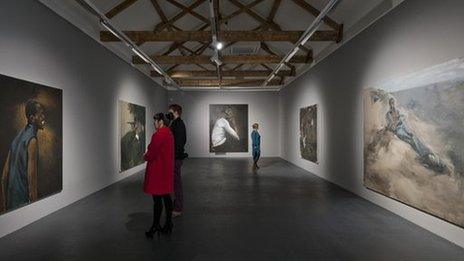
The old Ebrington Barracks in Londonderry is hosting this year's Turner Prize
There are lots more, including:
Shop Front Theatre, external, a theatre in an old fish and chip restaurant in a Coventry shopping arcade
Exchange Place, external, a new complex of artist studios in an old art deco stationery emporium in Sheffield
Gateshead Old Town Hall, external, which became home to artists and music classes after the council workers moved out
And as well as the grassroots, DIY projects, there are examples of more high-profile, big-budget and long-term conversions, including:
an art gallery in the old Tetley brewery, external in Leeds, which opens this week
a £3.2m makeover for Plymouth's Royal William Navy Yard
the transformation of Ebrington Barracks in Londonderry, which is hosting this year's Turner Prize. There is now a debate over whether the barracks should become a permanent gallery.
- Published9 October 2013
- Published10 September 2013
- Published15 August 2013
- Published14 March 2013
- Published24 February 2013
- Published1 November 2012
- Published22 September 2011
- Published21 June 2011